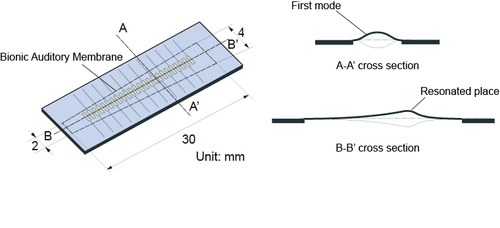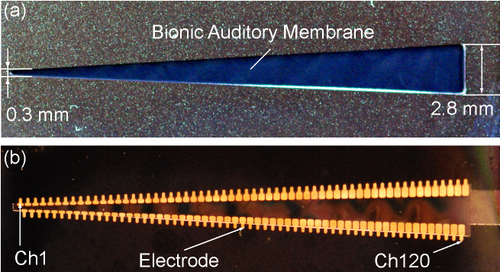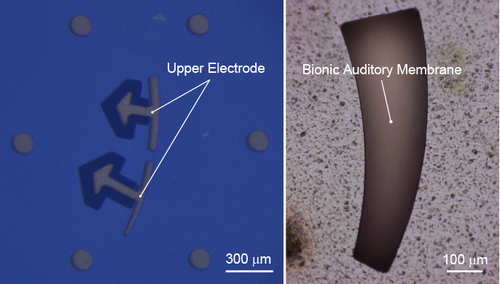大阪大学基礎工学研究科機能創成専攻機能デザイン領域 川野研究室
MEMS技術による新しい人工聴覚上皮の開発
難聴は聴覚の機能障害であり,伝音性難聴と感音性難聴に大別できる.
伝音性難聴は主として中耳における伝音機構の障害であるのに対して,感音性難聴は内耳の(主に有毛細胞やラセン神経節)機能低下・障害により引き起こされる.
特に,感音性難聴は65歳以上人口の約5割に見られる不可逆的な疾患であり,超高齢化社会を迎える我国において切実な社会的問題であると言える.
さらに,先天性難聴は1000人に1人程度に認められる最も頻度の高い先天性機能障害の一つであり,そのほとんどは感音性難聴である.
先天性難聴は,小児の感性,言語および知識獲得等に強い影響を及ぼし,生活の質(QOL:Quality of Life)を低下させる.
以上より,安全性および効果の高い治療法の開発は喫緊の課題であると言える.
そこで、厚生労働科学研究費補助金感覚器障害研究事業 ”ナノテクノロジー、再生医学を融合した人工内耳、人工蝸牛の開発”(平成19年度~平成21年度,代表:京都大学 伊藤壽一教授)では,MEMS(Microelectromechanical systems)技術を用いて,体外装置と電源を持たないStand alone型人工内耳の創製を目指している.さらに,超微細加工技術による電極数の増加,新たな周波数解析法による“自然な聞こえ”の実現を目標としている.本事業ではこれまでに,蝸牛の基底板形状を模擬した圧電音響センサ,すなわち,MEMS人工基底板を考案している.
人工基底板はその機械工学的特性から,音波の周波数に応じた特異的な振動様式を示し,周波数の識別を可能にし,異なる強度の電気信号を出力する.
これにより正常な内耳を模擬した周波数弁別能および音波-電気信号変換を実現しようとするものである.

図1 Schematic of prototype bionic auditory membrane (prototype BAM) with multi electrodes, and cross-sectional images of BAM's oscillations on A-A' and on B-B'. Frequency selectivity is realized by the resonance in the local place. The local resonant frequency is mainly determined by the first mode for width direction due to the relatively long and narrow structure.

図2 Photographs of (a) geometry of 2nd-generation BAM and (b) that with 120 electrodes. BAM has about twenty times higher efficiency of acoustic/electric conversion than that of prototype BAM; this high efficiency is achieved by a thin-film technology. BAM is made of 480 nm thick polyvinylidene fluoride trifluoroethylene (P(VDF-TrFE)) for piezoelectric material and 7.1 mm elastic layers including Si, SiO2, Pt and Au thin films.

図3 Photographs of electrodes and geometry of miniaturized BAM for implantation into a cochlea of a guinea pig. The geometry of miniaturized BAM is designed to fit the implanting place of scala tympani near the basal turn. The width changes from 100 mm to 230 mm to adapt the resonant frequency in the range of 16 kHz - 32 kHz which corresponds to the characteristic frequency of implanting place.
[1] Takatoshi INAOKA, Hirofumi SHINTAKU, Takayuki NAKAGAWA, Satoyuki KAWANO, Hideaki OGITA, Tatsunori SAKAMOTO, Shinji HAMANISHI, Hiroshi WADA, and Juichi ITO Piezoelectric Materials Mimic the Function of the Cochlear Sensory Epithelium Proc. Natl. Acad. Sci. USA, Vol. 108, No. 45 (2011), pp. 18390-18395.
[2] Hirofumi SHINTAKU,Takayuki NAKAGAWA, Dai KITAGAWA, Harto TANUJAYA, Satoyuki KAWANO, and Juichi ITO Development of Piezoelectric Acoustic Sensor with Frequency Selectivity for Artificial Cochlea Sensors and Actuators A: Physical, Vol. 158, Issue 2 (2010), pp. 183-192.